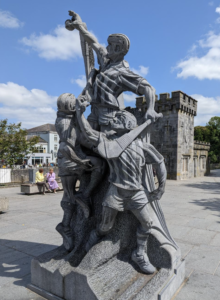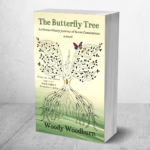Woody’s new novel “The Butterfly Tree” is available at Amazon (click here) and orderable at all bookshops.
*
This is a story of love at first sight and a second chance.
The first time I visited Ireland, a full decade ago, the national hurling championships were underway and I fell head over heels—much as the players often wind up on the grass pitch.
If you have never seen the ancient Gaelic sport of hurling, imagine soccer with 15 players instead of 11 per side; add in the bone-jarring-nose-bloodying physicality of rugby; then give the players wooden clubs that look like the offspring of a field hockey stick and a cricket bat. The “hurley”, as the shortened bats are commonly called, can be used for knocking out teeth as well knocking a baseball-sized sliotar past a goalie to score three points.
Even more exciting are the moonshots that would make Dodgers home-run slugger Shohei Ohtani proud, where a player swings from the heels, often while on the run, often too while being assaulted by a defender, and sends the high-seamed ball soaring cloud-high and nearly the length of the 150-yard field over the crossbar and between the uprights, much like a football field goal, for a single point.
Indeed, anywhere and everywhere on the field is a scoring opportunity. I dare say, and I mean this truly after spending three decades as a sports writer, championship-caliber hurling may be the most thrilling sport I have ever witnessed.
Upon returning home from the Emerald Isles, I hurled mild expletives at myself for not bring back a souvenir stick. Hence, when My Better Half and I recently returned to the land of my ancestors I aimed to rectify my lingering non-buyer’s remorse.
Opportunity knocked in Kilkenny, population 26,000, about 80 miles southwest of Dublin and once the great medieval capital of Ireland. Strolling a narrow cobblestone street en route to Kilkenny Castle, built in the 13th century, I spied a hurley in the cluttered window of a wee antique shop that looked nearly as old.
The stick was a sore sight for eyes. Age had turned the white ash—the same wood American baseball bats are generally made, prized for its hardness—grey as winter clouds. The ball-striking blade had a steel band, spotted with rust and dints, wrapped around the toe and tacked tightly in place to prevent the grain from splitting. Higher on the blade a bandage of black tape, now petrified by age, served a similar healing purpose.
Beauty, of course, is in the eye of the beholder and I felt called to go inside and embrace it. Caressing the handle, its nub like that of an axe, the age-worn wood was burnished smooth as ivory by blood, sweat and years of play. Gripping it, my fingers settled into subtle impressions formed by the hands of time and players.
Appraisal along the shaft revealed dings and dents, battle scars from clashing with other hurleys wielded like dueling sabers. If this stick could talk, Oh, the tales it would tell! I imagined – of winning goals and celebrations, and heartbreaking losses too; of broken bones, broken noses, broken dreams.
“Aye, I played in my britches days,” said the shop’s proprietor, a human antique perched on a stool behind the front counter stacked with this, that, and other bric-a-brac. As Irish as Guinness, and not much taller than a poured pint, George, as I soon learned his name to be, traced his nose, battered as the hurley in my grasp, and told me proudly: “Busted it more times than I can count playing. Needed my fair share of stitches, too.”
To be continued next week…
* * *
Essay copyrights Woody Woodburn
Woody’s new novel “The Butterfly Tree” is now available in paperback and eBook at Amazon (click here), other online bookstores, and is orderable at all bookshops.
*
Woody writes a weekly column for The Ventura County Star and can be contacted at WoodyWriter@gmail.com. Follow him on Twitter and Instagram at @woodywoodburn.



